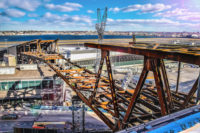LaGuardia Shoehorns $8B Megaproject At Busy Site

LaGuardia Airport’s 10-year overhaul is in full swing. It strives to maintain full operations by accomodating 100,000 passengers on peak days while erecting new structures— like the future Terminals B, C and D—and razing old ones.
PHOTO BY ERIC CHAN AND CHRIS VILLARI FOR SKANSKA WALSH JV AND LAGUARDIA GATEWAY PARTNERS

This rebar cage is for a column near Delta Terminal C that will support part of the 8 miles of new roadways at LaGuardia.
PHOTO BY ERIC CHAN AND CHRIS VILLARI FOR SKANSKA WALSH JV AND LAGUARDIA GATEWAY PARTNERS

To maintain equilibrium between passenger service and construction schedules, all activities must come with warnings days or weeks ahead of time regarding any possible impact.
PHOTO BY CHRIS VILLARI FOR SKANSKA WALSH JV AND LAGUARDIA GATEWAY PARTNERS



The $7.9-billon, 10-year overhaul of New York City’s LaGuardia Airport—outdated, crowded and derided by passengers, pilots and politicians—is monumental enough, with a crowd of contractors using unique project delivery approaches to replace its three busiest terminals and upgrade complex infrastructure on a tight site hemmed in by water and highways. Amid that tally of risk factors, along with Gov. Andrew Cuomo (D) as a watchdog over one of his signature projects, LaGuardia strives to maintain full operations by accommodating 100,000 passengers on peak days while erecting new structures and razing old ones.
Construction of twin facilities totaling 2.5 million sq ft to replace existing Terminals B, C and D follows a meticulous phasing plan that aims to keep passengers flowing to and from their planes at the facility in East Elmhurst, Queens. Along with safety, maintaining airport operations “takes complete priority,” says Richard J. Smyth, redevelopment project executive for LaGuardia, which is run by the Port Authority of New York and New Jersey.
“We coordinate all of the work around the operational needs of the airport,” he says. “We do work at night because there are no flights and we can shut down roads. We have a four-, five- or six-hour window that we can work in.”
But delays from weather, system glitches or other schedule issues shorten that window significantly on some nights, says Smyth, former corporate real estate vice president for Jet Blue Airways. And all activities—pile-driving, concrete pours, steel erection or roadway construction—must come with warnings days or weeks ahead of time about any impact at a facility that serves 40,000 travelers per acre, double the next -most crowded U.S. hub, he says. “Solving for customer movement—getting into and out of the airport—was a challenge even before we started,” Smyth adds.
Such matters guide every task, says Derek Thielmann, project director for design and construction at LaGuardia Gateway Partners (LGP)—the public-private partnership (P3) joint venture of Vantage Airport Group, Skanska, Meridiam and JLC Infrastructure—which is the developer of the new $4-billion Terminal B.
“How we are able to build efficiently but keep the operation functioning is something we spend pretty much every day on, to be honest,” he says. “We’re literally trying to build a new airport on top of an existing airport that remains in operation.”
That effort’s mirror image is a $3.9-billion facility that Delta Air Lines is building to replace today’s C and D terminals, says Ryan Marzullo, the carrier’s managing director of corporate real estate in New York. “The goal of the program has been not to take down any capacity,” he says. “We keep flying our full schedule.”
The operations fixation turns seemingly straightforward tasks into orchestral efforts, Smyth says. Relocating taxi loading areas requires coordination with airport and taxi commissions, while moving cranes needs Federal Aviation Administration approval, he says.
Big Picture
LGP and Delta are in for the long haul, each planning to lease and operate their terminals from the Port Authority through 2050.
LGP’s Terminal B is a design-build project, with a Skanska-Walsh Group construction joint venture in the lead and HOK and WSP USA as design partners. The heart is a new 1.3-million-sq-ft terminal, which includes an 840,000-sq-ft headhouse for baggage, ticketing, security, concessions and other administrative functions. It also has two island concourses with 35 flight gates and concessions. Each concourse connects to the headhouse via 370-ft-long pedestrian bridges with clearance of at least 56 ft to span over planes taxiing below.
The project also entails building a central utilities plant; 8 miles of road, including 20 bridges; so-called airside facilities, such as three miles of widened and improved taxi lanes airside and throughout the property; and a 2,700-space parking garage. Terminal B project expenditures reach $100 million per month, Smyth says.
Work began in 2016, and the parking garage opened earlier this year. Next to be finished, this fall, is Terminal B’s first island concourse and some roads. Then the headhouse and the rest of the roadways are expected to be done in 2020, and the other concourse in 2022.
The effort involves 28 unions and a team of 2,400 professional and trade workers, says Thomas Nilsson, a Skanska-Walsh vice president.
Delta’s design-bid-build project for a new 1.2-million-sq-ft Terminal C entails a 425,000-sq-ft headhouse and 37 gates across four flight concourses as well as roadwork, taxi lanes and a 21,000-sq-ft substation, Marzullo says.
Delta’s team—STV and Satterfield & Pontikes Construction as construction managers, Burns & McDonnell as engineer and Corgan as architect—broke ground last summer. Foundations are complete on the first concourse, with steel erection under way, Smyth says. The team will complete the headhouse and two of four concourses as well as roadways in 2021. The other concourses come online in 2024 and 2026.
In both efforts, the teams repurposed parking or other facilities for the new terminal footprints, allowing construction to advance while maintaining operations in existing terminals. And both projects have LEED-certified sustainable designs, with elements such as onsite concrete recycling; reuse of water pumped out during excavation to create lightweight fill elsewhere; planned rainwater collection; solar panels; and water conservation features.
Each developer also is building part of a new central hall to link the two terminals and possibly serve as the terminus for a proposed AirTrain rail link and a hotel. The AirTrain came a little closer to reality with a new law Cuomo signed in late June that authorizes $1.5 billion for a 1.5-mile elevated rail line that will connect the airport to subway and commuter rail lines at Willets Point near Citi Field in Queens. Construction is planned to begin in 2020 and finish in 2022.
The entire schedule is front-loaded, Smyth adds. “By 2022, we’ll have all of Terminal B and the majority of Terminal C in place,” he says.
Unique Delivery
A critical element shaping the program was the Port Authority’s openness to different contract and delivery approaches. Project participants say that kind of flexibility, and coordination among all players, solved numerous challenges.
One example is how the P3 structure opened the door for Vantage, an airport operator, to lead the Terminal B bid, Thielmann says. That added an operator’s view early on, instead of the typical “layered” design-build approach in which designers hatch a blueprint, then hand it off for constructibility and finance reviews, he says.
“It was actually led by the people who are going to operate the airport for the next 35 years,” he says.
LGP crafted a vision that was nothing like the Port Authority’s reference design, a more complicated plan with 16 construction phases over 80 months, Thielmann says. The concept of a headhouse with island concourses helped condense the program to five phases and shaved off two years, he says.
That plan let the team to “build less building, which is more efficient [and] cost effective,” he says. “It reduced our circulation corridors and walking distances. And it also moved the airport closer to the Grand Central Parkway, which … created two miles of additional airside taxi lane,” reducing traffic and gate congestion.
The approach even opened up the land that was later designated for the central hall, and paved the way for Delta’s own program. LGP also recommended that the Port Authority wrap $800 million of road and infrastructure work into its bid to better coordinate with the larger project—assets that it will turn over to the agency upon completion, Thielmann says.
Delta’s approach also is atypical, a multiple prime contractor format with the airline holding design and trade contracts directly, Marzullo says. “Yes, we take on the risk, but we take on control,” he says. “We want the transparency and the visibility built into the program. It gives us capability to adapt and react … without having a general contractor seem at risk or a design-build contractor hitting us with a change order every time something happens.”
That control lets Delta prioritize ways to reduce impact on passengers, such as sequencing to limit temporary facilities and transitions, Marzullo says. For instance, it will be able to fully test headhouse operations in advance. “We basically flip the switch overnight,” he says.
The contracts also feature extensive private capital, with $2.5 billion in project bonds sold for Terminal B as well as Delta funding $3.3 billion of Terminal C’s budget.
Logistics and Surprises
Sophisticated phasing can’t solve every issue, such as lack of laydown areas—no small challenge on Terminal B, which will use 40,000 tons of steel and 7,000 piles.
Coordinating traffic, navigating bridges and scheduling nightly on-time deliveries have become regular tasks, Smyth says. “Next year we will be dealing with that on [Terminal B’s] Concourse A, but we have real good practice,” he says.
And while the team expected poor soils at LaGuardia, drilling through fill and riprap from an old boat basin was difficult on piles that averaged 100 ft in depth, Nilsson says. “We broke about 10% to 15% of all the piles,” he says. Skanska-Walsh divided the job into 12 internal projects to isolate and manage such issues, Nilsson says. “We assigned a project manager to each area.”
The teams still face other challenges from overlapping old and new spaces, such as needing to relocate Terminal B’s fire alarm panel and temporarily harmonize a new heating and cooling system with the existing building, Thielmann says. Delta’s team addressed needing power to support its new terminal and not having room for a substation by designing the 12-megawatt facility atop one concourse. Passengers won’t know it’s there in the “stout structure,” Marzullo says.
Large construction programs always have snags. Early on, LaGuardia roadway traffic at times came to a standstill, says Warren Schreiber, co-chair of the New York Community Aviation Roundtable, an airport advisory group. The Port Authority told his panel it has addressed the problems with better traffic flow controls, he says.
The congestion stemmed partly from project designs predating the rise of ridesharing services, Nilsson says. Rideshare drivers swarmed for fares, circulating to avoid parking fees and quickly clogged roadways, he says. “When we bid the job, Uber had barely started,” he says. The team in May designated part of the garage, with dedicated entrances and exits, to accomodate for-hire vehicles, and the format was working in its first weeks, Smyth says.
Another snag is the team has not sought community input on the redevelopment, Schreiber says. Project representatives presented a first report to the roundtable’s LaGuardia committee only a month ago, he says. “Everybody’s pleased the project is taking place, no doubt about it,” he says. “But they have not asked community stakeholders … to be part of their advisory group. We would absolutely welcome it—there should be more involvement from the community.”






